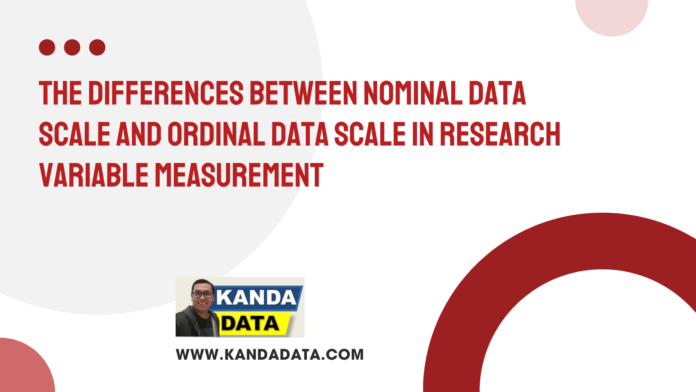In statistical analysis, data measurement scales are divided into four main categories namely nominal scale, ordinal scale, interval scale, and ratio scale. A proper understanding of the differences among these scales is crucial for determining the appropriate data analysis method.
Based on these data measurement scales, nominal data scale and ordinal data scale are widely used in non-parametric statistical analysis. The distinction between nominal and ordinal scales will determine the choice of the appropriate non-parametric analysis for processing research data results.
Today, Kanda Data will write an article on the differences between nominal data scale and ordinal data scale in measuring research variables.
Nominal Data Scale: Definition and Examples
The nominal data scale is the simplest measurement scale. It is used to categorize or classify objects without considering any order or ranking. The main characteristic of the nominal data scale is the absence of ranking or levels among its categories. Common examples of nominal scales include gender, occupation, type of vehicle, and color.
For instance, the variable gender is classified into two categories namely male and female. In this case, there is no order or ranking indicating that one category is higher or lower than the other.
Nominal scales are often used to measure dummy variables. For example, when a researcher wants to measure the impact of import policies on the domestic production of a product, the import policy variable can be categorized into before the import policy (score 0) and after the import policy (score 1).
Ordinal Data Scale: Definition and Examples
The ordinal data scale has slightly higher complexity compared to the nominal scale. This scale not only categorizes objects but also considers the order or ranking among these categories. However, the intervals between the ranks are inconsistent or unknown. Examples of ordinal scales include education level, ranking, and variables using the Likert scale.
For example, in the variable education level, someone who graduated from high school has a higher education level compared to someone who graduated from junior high school. Conversely, someone who graduated from elementary school has a lower education level compared to someone who graduated from junior high school.
In research, the ordinal scale is often used to measure variables such as consumer satisfaction using the Likert scale. An example would be a study using a Likert scale from 1 to 5 to measure consumer satisfaction, with categories ranging from very dissatisfied, dissatisfied, neutral, satisfied, to very satisfied.
Closing Remark
From the discussion on the differences between nominal data scale and ordinal data scale, it can be concluded that these two scales are often used in non-parametric statistical analysis. Variables measured using the nominal scale tend to be simpler compared to the ordinal scale. A proper understanding of these differences will aid in the selection of the appropriate statistical test for data analysis.
This article is designed to provide new insights to readers on the differences between nominal and ordinal data scales. We hope it is beneficial and enhances your knowledge. For more educational content, visit the YouTube channel “Kanda Data.” See you in the next educational article.

